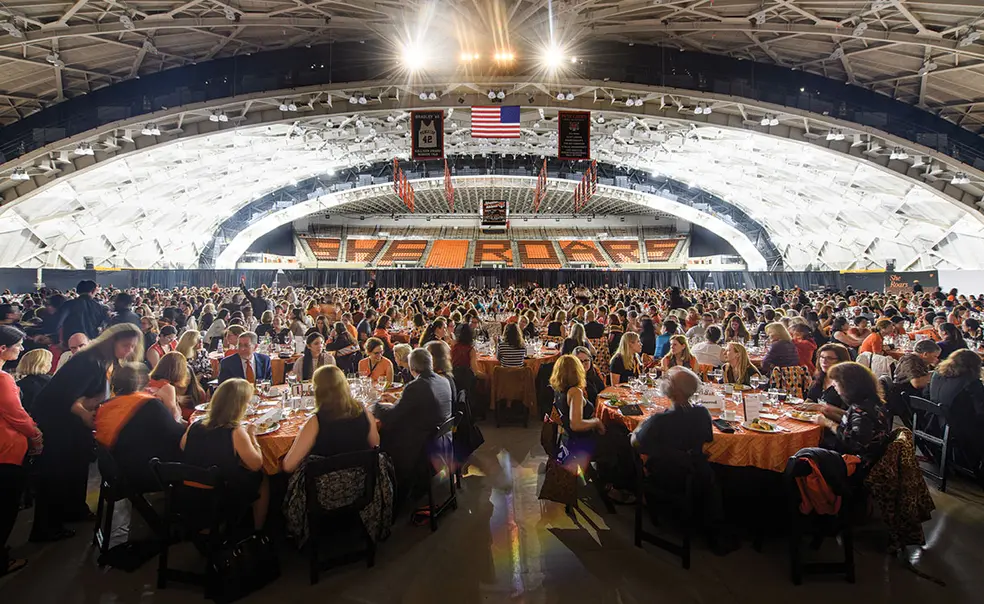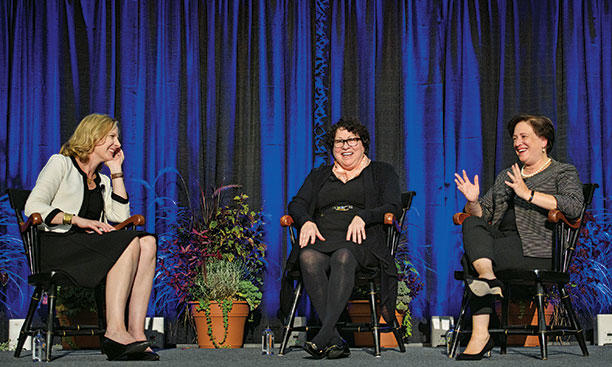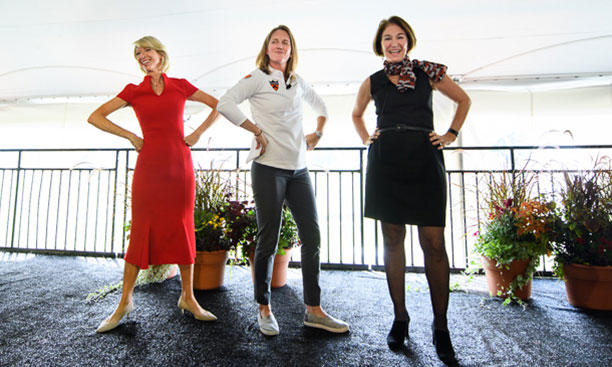She Can Do It!
At She Roars, alumnae return to campus to discuss — and celebrate — their role in society and at Princeton
All weekend, in every corner of campus, Princeton women proudly took up space.
They filled the seats and bleachers of Jadwin Gymnasium, listening to Supreme Court Justices Elena Kagan ’81 and Sonia Sotomayor ’76 describe their years at Princeton and the changing balance of the court. They gathered in small classrooms to find strategies for coping with everyday challenges — caring for parents and children, advancing in the workplace, dealing with sexual harassment — and in large halls to celebrate their successes. They jumped out of their seats in a massive Poe Field tent when the three luncheon speakers — former Woodrow Wilson School Dean Anne-Marie Slaughter ’80, women’s basketball coach Courtney Banghart, and social psychologist Amy Cuddy *05 — stood together on stage, their hands on their hips in “power poses.” The audience members gave them a standing ovation, cheered, and adopted power poses, too.
“When people win, they take up space,” Cuddy, who has researched benefits of the poses, told them. Taking up space, she said, makes people feel powerful — and feeling powerful changes the way we see the world.
It was one empowering moment among many at Princeton’s She Roars conference, which brought about 3,400 alums back to campus Oct. 4–6, the vast majority of them women. Throughout the weekend, there was a strong sense of sisterhood as alumnae from across generations hammered out ideas about how to chip away at the nation’s gender gap. Against the political backdrop of the #MeToo movement and Judge Brett Kavanaugh’s confirmation to the Supreme Court, participants explored ways to better the lot of women in our country, including by running for office. But they also took time to celebrate each other’s company during lighthearted events like a wine tasting and late-night dancing.
“Use your talents to get more civically engaged,” advised Rep. Terri Sewell ’86, the only Democrat and only African American in Alabama’s congressional delegation, in an electric Friday-morning breakfast talk. She called on alums to break out of the “tribalism echo chamber” and to commit to three actions: to drive five people to the polls on Election Day, to “adopt a woman candidate and help her win,” and to give back to the community and to Princeton.
At lunch that day, Slaughter, Cuddy, and Banghart spoke about leadership in fast-paced TED-Talk style. Slaughter, who now leads the New America think tank, asked the audience to imagine a world of true gender parity, “where a woman could marry the man of her dreams regardless of whether he is more ambitious than she is,” where men and women are equally represented in caregiving jobs, and where “those jobs would be as valued as investment banking.” In such a world, she said, “we’d spend as much on early childhood education, and on all education, as we spend on defense.”
She acknowledged that she had felt “a physical weight” because of the headlines from Washington, and that many women felt rage and despair. “We have to find a way forward to a world of equal dignity and respect for all human beings,” she said. “And that includes white men, because they cannot become the enemy.”
A Saturday-morning event sponsored by Princeton’s James Madison Program offered She Roars attendees conservative views on “viewpoint diversity” and balancing family and career. “On a social and interpersonal level among students, it is not easy to be an outspoken conservative here,” said Allison Berger ’18, who noted she has been called a “traitor to my gender.” She said the situation is “a lot worse” at most other universities, but that intolerance for conservative viewpoints at Princeton prevents valuable conversations from taking place.
The weekend’s marquee event was a conversation with Supreme Court Justices Sotomayor and Kagan in Jadwin Gym. The justices spoke about their careers and their experiences at Princeton with moderator Heather Gerken ’91, dean of the Yale Law School.
Gerken steered clear of the divisive confirmation process then underway in Washington, but she noted that the Supreme Court has always been understood as a neutral arbiter and asked how the two justices saw their role. Kagan responded first, explaining that part of the court’s strength and legitimacy depends on people seeing it as “somehow above the fray.” She continued, saying it has been “an extremely important thing” that for the last 40 years, until the departure of Justice Anthony Kennedy this year, there has been a justice at the center, so that the court was not seen to “belong to” one side or the other. “Now,” she said, “it’s not so clear whether we’ll have it. All of us, every single one of us, needs to be aware of that.”
Sotomayor said the justices understand “that we have to rise above partisanship in our personal relationships.” Sotomayor, among the court’s liberal justices, said she has worked with conservative Justice Neil Gorsuch to promote civics education.
“It is just the nine of us,” Kagan said. “If you hold grudges or if you have a bad relationship with one of your colleagues, then in the next case you have not much of a chance of persuading that colleague.”
Many women at the conference acknowledged the difficulties they have faced, and continue to face — including a lack of confidence. In a Saturday-lunch conversation between Shirley Tilghman, the first female president of Princeton and Sally Blount ’83, the first female dean of the Kellogg School of Management at Northwestern University, Tilghman was asked how long it took for it to feel “good enough” — a reference to the “imposter syndrome” that others have discussed. Tilghman hesitated for a moment before replying with an answer that surprised the crowd: “Never.”
Later, during the question-and-answer period, participants adopted by acclamation a statement co-authored by Georgia Nugent ’73, former president of Kenyon College. “We are united in our advocacy, particularly at this moment in our national life, for the importance of women’s voices being heard, respected, and acted upon,” the statement says, in part. “We want to affirm the energy and power of women speaking together and on each other’s behalf, recognizing ... that what benefits women benefits everyone.”Alumnae of Princeton’s first coed classes were recognized with hearty applause during a session about the arrival of undergraduate coeducation at Princeton in 1969. Historian Nancy Malkiel, former dean of the College, asked the “pioneering women” from the classes of 1970 to 1973 to stand, praising them for their “courage and sheer gumption” for enrolling at the University and “for making Princeton better and stronger in every way.”
Malkiel recounted key points from Keep the Damned Women Out, her history of coeducation at elite U.S. and British schools in the late 1960s, saying that Princeton’s decision to admit women was not an act of altruism but was meant “to improve the educational experience of men.” Despite fierce opposition from alumni and antipathy from some faculty and students, she said, “Princeton coeducated more successfully” than its peers.
Asked about issues that remain to be addressed at Princeton, Malkiel cited the need for more women faculty members, a gender imbalance among graduate students, the lack of undergraduate and graduate-student women in some academic departments, and a question “that is still open” about the participation of female students in the highest-profile leadership positions.
“This conference is a way for those of us who came in the early days to see how much progress has been made,” journalist Helen Zia ’73 told PAW. “There are still things that need to be done, that need to be carried on by the new generation.”
The conference concluded on a light note with an address by comedian, writer, and actress Ellie Kemper ’02. She spoke about the many “confident, strong women” she has worked with, including her mother, Dorothy Jannarone Kemper ’72, a “strong, opinionated, brilliant woman,” and Tina Fey, her director and boss on the show Unbreakable Kimmy Schmidt. Kemper also read from her new memoir, My Squirrel Days, about meeting her Princeton field hockey coach, Beth Bozman. From that encounter, she learned that “women are at their best when we are helping other women. ... We listen to one another. We don’t interrupt one another. Having a tough conversation with an intimidating woman showed me that women find strength from each other,” Kemper said.
She ended by thanking a man —President Eisgruber ’83 — and the Princeton community: “Thank you for promoting us and believing in us and for realizing you would be totally lost without us.”














5 Responses
Rachel George ’10
7 Years AgoReflecting on She Roars
The She Roars conference (story, page 39) couldn’t have fallen on a more perfect and poignant time for so many of us. I joined the conference after a long flight from London, where I currently reside. For me, it was an ideal moment, as I’ve been in a transitional moment in my career while also feeling swept up not only in America’s current political climate but also in life abroad, and I was so eager to jump into conversations with fellow Princeton women.
After earning my Ph.D. in international relations at the London School of Economics last year, attending the She Roars panel on “Liberating the Ph.D.: Diverse Career Paths with a Doctorate” was the perfect opportunity for conversations to help tease out many of the anxieties, questions, and curiosities I currently face in exploring next steps in my career.
Complementing such targeted panels with a range of sessions on issues unrelated to my studies — exploring journalism, wellness, leadership, and other areas — was a welcome respite from the more specific advice I was seeking and provided many undiscovered sources of information and inspiration. Topping this off with meals shared with dear ’10 friends alongside Princeton ’73 and ’74 women who told remarkable stories of persistence and drive — all with an incredible sense of humor and camaraderie — was more than I could have expected from just three short days.
Ellis Liang ’15
7 Years AgoReflecting on She Roars
When I saw that Brett Kavanaugh had been confirmed, I felt the disappointment and bitterness I had experienced after Hillary Clinton lost. But this time, I was in the company of 3,400 alumnae at the She Roars conference. Congresswoman Terri Sewell ’86 of Alabama had told us the power of contributing to women electoral candidates. Justices Sonia Sotomayor ’76 and Elena Kagan ’81 had shared their strategies for amplifying female voices on the Supreme Court. Samara Bay ’02, a dialect coach for women candidates, explained that women are less self-conscious when we advocate for issues or other people.
On the last night, I was on the dance floor, surrounded by women of all shades, ages, and political persuasions, moving without inhibition and with so much joy. I draw strength from the generations of women before me, who faced not only a national administration that treated them as the lesser sex but also a University administration that did the same.
Nevertheless, they persisted. They fought to make Princeton ours. They are still fighting to make workplaces, the media, science and technology, health care, the academy, and political institutions ours. Hell hath no fury like a woman who is not represented. We will run, we will fund-raise, we will vote, we will litigate, we will advocate, we will speak, and we will be heard.
Hope for me is a dance floor of women, arms raised, claiming all the space we deserve, and singing: I got the eye of a tiger, a fighter, dancing through the fire, ’cause I am a champion, and you’re gonna hear me roar!
Pauline C. Reich CL '66-'67
7 Years AgoStill Excluded
Twelve female students lived in an off-campus house while taking classes with 3,000 male students, paying tuition, taking exams, writing research papers. Critical Language students, we were called “Critters,” and the 1967 yearbook says we were a “pleasant diversion.” Our male counterparts from the same universities could stay on at Princeton to graduate, but we could not. We are still excluded from having our accomplishments reported in PAW and membership in Princeton Clubs worldwide. Time for a change — give us the same privileges as the two-years-later female attendees!
Pauline C. Reich CL '66-'67
7 Years AgoThe Forgotten Pre-Coed Cohort
Happy to see the younger women who benefited from attending Princeton as undergraduates. Those of us who attended just before coeducation continue to be excluded from She Roars, membership in Princeton Clubs worldwide though we paid tuition, attended classes, earned grades. We could not join the eating clubs and had to live in a large house on Library Place rather than on campus.
President Eisgruber, please resolve the present effects of past discrimination and have a look at what Williams College has done about inclusion and access.
Thank you.
Lindianne Sarno ’76
7 Years AgoThis Is Her Roar: A Call to Musicians
A Call to the Musicians of Homer, Alaska (and America)
By Lindianne Sarno
Oct. 22, 2018
Sitting with Rep. Paul Seaton at the K-Bay Caffe today
I mention Ray Metcalfe sent a message through Lela
Asking me to chair the Democratic Party on the south Kenai Peninsula.
I say, I would rather organize the musicians.
So Paul Seaton envisions musicians playing together every day
Leading up to a full Election Day of music
Outdoors, under a gazebo if it rains;
Peace Park, Gazebo Park, WKFL Park would be ideal.
Call the newspapers and radio, advised Paul Seaton.
What are Musicians for?
Musicians are troubadours and transformers of energy.
Musicians are prophets, builders of humanity’s hope for a good future.
Living by an ethic of humility
We musicians humbly serve each other in rhythm and harmony.
When we have the stage or the microphone we have power.
Musicians, use your voice generously and wisely in these two weeks
Leading to the most important election of our lives.
Historians will look back at the mid-term election of 2018
As the turning point when America came to its senses and
the people averted a rising tide of fascism.
Where musicians gathered and sang and played
Listeners came out, libations flowed, pies and soups were shared.
Youth and elders together aired the concerns of 2018
Candidates showed up to listen
And we the people all voted.
The lame and the old, the young and the hopeful
The rich and the poor, the sick and the healthy
The wealthy and the hungry
The immigrant and the established
We all came out to listen and speak at music parties across America
Rides and early votes were arranged to make sure
Everyone who wanted to vote did vote.
America Rocked the Vote, Gospel’d the Vote, Folk’d the Vote,
Country’d the Vote, Jazzed the Vote, Punk Rocked the Vote,
Classic’d the Vote! Everyone was included!
Because the Musicians said, Regardless of your party
Come to this Party of Parties
God is welcome
And Jesus is welcome
And Mohammed is welcome
And Mother Earth and her Nations are welcome.
Even those who sin in arrogance and pride
Who make war and dominate and presume to decide
Who shall live and who shall die
You too are welcome in the name of truth, goodness and beauty
Provided you promise nevermore to lie to the people.
This call to musicians is a recipe for freedom.
What does your heart call you to do?
I will bring my five-string fiddle
Built by Ray DeMeo in Anchor Point, Alaska
Of Sitka spruce and Vermont maple
And fiddle for the singers and players.